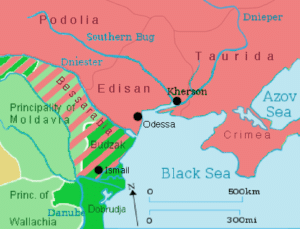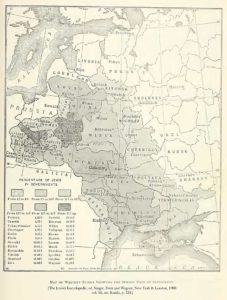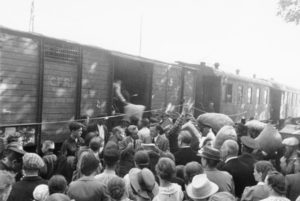
The Treaty of Paris (1856) returned the southern part of Bessarabia (later organised as the Cahul, Bolgrad and Ismail counties) to Moldavia, which remained an autonomous principality and, in 1859, united with Wallachia to form Romania. In 1878, as a result of the Treaty of Berlin, Romania was forced to cede the three counties back to the Russian Empire.
Over the 19th century, the Russian authorities encouraged the colonization of Bessarabia by Romanians, Russians, Ukrainians, Germans, Bulgarians, Poles, and Gagauzes, primarily in the northern and southern areas vacated by Turks and Nogai Tatar, the latter having been expelled in the 1770s and 1780s, during Russo-Turkish Wars; the inclusion of the province in the Pale of Settlement also allowed the immigration of more Jews. The Romanian proportion of the population decreased from an estimated 86% in 1816, to around 52% in 1905. During this time there were anti-Semitic riots, leading to an exodus of thousands of Jews to the United States.

World War I resulted in the union of Moldova with the Kingdom of Romania with the support of the Allied nations. This union was not recognized by the Soviet Union which regarded the union as an occupation of Russian territory by the Romanians.
World War II and Soviet Era:
In August 1939, the Molotov–Ribbentrop Pact and its secret additional protocol were signed, by which Nazi Germany recognized Bessarabia as being within the Soviet sphere of influence, which led the latter to actively revive its claim to the region. On 28 June 1940, the Soviet Union issued an ultimatum to Romania requesting the cession of Bessarabia and Northern Bukovina, with which Romania complied the following day. Soon after, the Moldavian Soviet Socialist Republic (Moldavian SSR, MSSR) was established, comprising about 65% of Bessarabia, and 50% of the now-disbanded Moldavian ASSR (the present-day Transnistria). Ethnic Germans left in 1940.

As part of the 1941 Axis invasion of the Soviet Union, Romania regained the territories of Bessarabia and Northern Bukovina, and seized a territory which became known as Transnistria Governorate. Romanian forces, working with the Germans, deported or massacred about 300,000 Jews, including 147,000 from Bessarabia and Bukovina. Of the latter, approximately 90,000 died. Between 1941 and 1944 partisan detachments acted against the Romanian administration. The Soviet Army re-captured the region in February–August 1944, and re-established the Moldavian SSR.
In 1946, as a result of a severe drought and excessive delivery quota obligations and requisitions imposed by the Soviet government, the southwestern part of the USSR suffered from a major famine. In 1946–1947, at least 216,000 deaths and about 350,000 cases of dystrophy were accounted by historians in the Moldavian SSR alone. In 1944–53, there were several anti-Soviet resistance groups in Moldova; however the NKVD and later MGB managed to eventually arrest, execute or deport their members.
